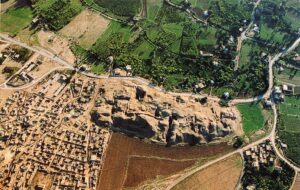Once Israel left Egypt, they began a journey to the land God had promised them. Unfortunately, due to their disobedience and lack of faith, God prevented them from entering the land for forty years until after the unfaithful generation had passed. At that time, Joshua led them into the Promised Land, beginning with the conquest of Jericho.
Wilderness Wanderings
Archaeological evidence for Israel’s 40-year “wilderness wanderings” has been found in the form of multiple inscriptions on the walls of two Egyptian temples and a temple pillar in Sudan. The inscriptions date as early as ~1,400 BC (~40 years after the Exodus) and reference the “land of the nomads of Yahweh.”1
These inscriptions are important for two primary reasons.2 First, they describe the Israelites, during the timeframe of the wilderness wanderings, as “nomads,” supporting the biblical narrative. Secondly, they represent the oldest known reference to “Yahweh” outside of the Bible. The use of God’s personal name shows that the Egyptian pharaoh immediately following the Exodus was familiar with the God of Israel.
Jericho
Upon completion of their time in the desert, the first city Israel entered in the Promised Land was Jericho. The book of Joshua details how the Israelites, with God’s assistance, were able to capture the heavily fortified city with minimal time and effort.
Jericho was first excavated by John Garstang in the 1930s. Based on the pottery he examined there, Garstang dated its destruction at ~1,400 BC,3 in perfect accordance with a ~1,446 BC Exodus followed by a 40-year wandering.
In addition to the timing of the conquest, biblical archaeologist Bryant Wood reports several other details about Jericho’s destruction consistent with the biblical narrative (all references from footnote 4 unless otherwise stated):
- Jericho was a strongly fortified city (Joshua describes it as a walled city in multiple verses)
- The city was massively destroyed by fire (Joshua 6:24)
- The thick city walls collapsed during its destruction (Joshua 6:20)
- In addition, the walls fell outward which is not what would have happened via ancient siege tactics. The unique wall destruction is consistent with the Bible’s narrative of a miraculous act by God to give Israel access to the city.5
- The siege of Jericho was short (Joshua 6:1-21) and the evidence verifies this as the city still had significant stores of unused grain available.
- The grain was not plundered in keeping with God’s command to the Israelites not to take any of the possessions. (Joshua 6:17-19)
- Jericho was abandoned for a time after its destruction, in keeping with Joshua’s curse on the city. (Joshua 6:26)
- On the north side of the city, houses were built on the rampart between the lower and upper city walls.6 Some houses were right up against the city wall, effectively being a part of it. This is completely consistent with the description of Rahab’s house in the city wall (Joshua 2:15). Interestingly, the city wall did not collapse in this area, in keeping with the Israelites’ promise to spare Rahab and her household (Joshua 6:25).
Dating of the Conquest
It bears mentioning that there is much debate around the proper dating of the conquest of Jericho. As noted, the initial excavation done by John Garstang concluded that Jericho fell ~1,400 BC in agreement with the biblical timeline. Subsequent excavations by Kathleen Kenyon in the 1950s redated Jericho’s fall to ~1,550 BC.7 This earlier date would mean that the Israelites were not the ones to capture the city and the biblical narrative of the Conquest is in error. So which dating is correct?
Unfortunately, the issue of when Jericho fell is one of the questions of ancient history that is very difficult to answer definitively. Various dating methods have given inconsistent results, though there is solid archeological evidence to support the 1,400 BC date. A summary of the evidence (for both dates) includes:
- Both John Garstang’s and Kathleen Kenyon’s competing dates were based on analyses of pottery found.
- Biblical archaeologist Bryant Wood disputes Kenyon’s dating and reaffirms the ~1400 BC date, also using pottery.8
- Carbon-14 dating of charred remains date the destruction anywhere between 1,347 – 1,690 BC9, which could support either date. The majority of C-14 tests are consistent with the earlier (~1,550 BC) date. However, it is worth noting that C-14 dating is often inconsistent and inexact, so this evidence is anything but conclusive.
- Amidst the controversy, archaeology may have come to the rescue. Also found in Jericho is a near continuous series of Egyptian royal scarabs spanning from the 18th to the beginning of the 14th centuries BC.10 Two of the scarabs are from the reign of Amenhotep III whose rule began in ~1,390 BC. The presence of the scarabs shows the city was continuously inhabited well after Kenyon’s ~1,550 BC date up until its destruction and abandonment in a similar timeframe as the ~1,400 BC biblical date.
Conclusion
In summary, there is archaeological evidence to support the wilderness wanderings of Israel and the conquest of Jericho in a manner entirely consistent with the biblical narrative. While the dating of Jericho’s fall is debated, there is solid evidence to support the ~1,400 BC timeframe. The Bible has once again proven itself very reliable, both in regard to its recorded history and reported miracles.
Notes:
- Kennedy, Titus. Unearthing the Bible. Harvest House Publishers 2020. Pgs 60-61
- Pg. 61
- Mahoney, Timothy and Law, Steve. Patters of Evidence – Exodus. Thinking Man Media 2015. 239
- Price, Randall. The Stones Cry Out. World of the Bible Ministries, Inc. Pgs. 152-153
- Mahoney, Timothy and Law, Steve. Patters of Evidence – Exodus. Thinking Man Media 2015. 240
- Pg. 242
- Price, Randall. Cit. Pg. 152
- Pg. 152
- Woods, Bryant. Carbon 14 Dating at Jericho. https://biblearchaeology.org/research/chronological-categories/conquest-of-canaan/4051-carbon-14-dating-at-jericho
- Kennedy, Titus. Cit. Pgs. 68-69.

